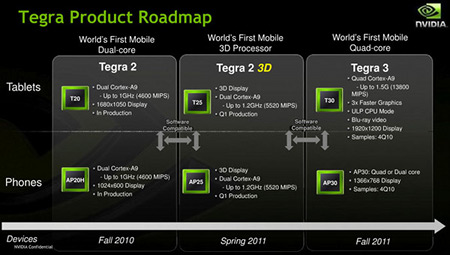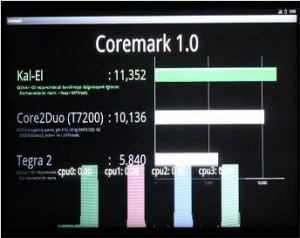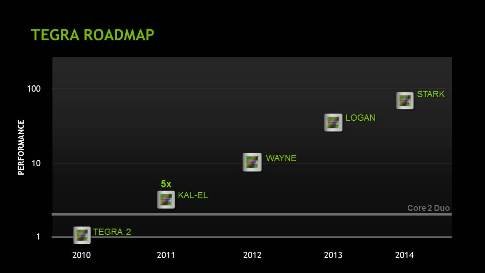Nvidia quad-core SoC to offer 1440p video
Feb 16, 2011 — by LinuxDevices Staff — from the LinuxDevices Archive — 2 viewsAs anticipated, Nvidia used the Mobile World Congress (MWC) in Barcelona to confirm its next-generation Tegra SoC (system on chip), which will feature quad cores and support 1440p (2560 x 1440 pixel) resolution. Code-named “Kal-El” but likely to be called “Tegra 3” upon release, the device will include four ARM-based CPU cores and a twelve-core GeForce CPU (graphics processing unit), the company says.
Nvidia's Tegra 3 was expected to be announced at this week's Mobile World Congress in Barcelona, but was preceded slightly by Qualcomm's announcement of its quad-core Snapdragon APQ8064. However, Qualcomm said its four-core SoC (system on chip) will begin sampling in early 2012, whereas Nvidia says it is sampling now and will be providing production quantities in August.

This leaked Nvidia slide showed the Tegra 3
Source: Engadget
(Click to enlarge)
Nvidia provided demonstrations of its new device today, referencing only the "Kal-El" codename rather than the Tegra 3 moniker. According to the above slide, reproduced in January by Engadget and other websites, the SoC will offer four ARM Cortex-A9 cores clocked at up to 1.5GHz.

Kal-El performance
Nvidia's blog posting this afternoon did not provide information about the ARM-based CPUs, but did say that Kal-El will include a 12-core GeForce GPU. According to a slide (above) released by the company, this will offer better graphics performance than Intel's 2.0 GHz Core 2 Duo T7200, and, more pertinently, also double that of the earlier Tegra 2, says Nvidia.
Nvidia also touted "Wayne," a Tegra scheduled for 2012 that will double Kal-El's graphics performance. Further chips codenamed "Logan" and "Stark" will outpace the original Tegra 2 by approximately 50 and 80 times, according to another slide (below) released by the company.

Nvidia's Tegra roadmap
Nvidia says Kal-El will allow tablets, smartphones, or other devices to provide 1440p (2560 x 1440 pixel) resolution. This was demonstrated at MWC on an Android tablet, scaled down to that device's native 1366 x 768 pixel resolution but also displayed on a connected 30-inch monitor, according to Engadget, whose report says "we saw no signs of it struggling."
Nvidia didn't mention 3D, though given the enthusiasm being shown by other vendors for stereoscopic displays, it's a fair bet that Kal-El's twelve GPU cores can also be used to induce seasickness, epilepsy, or debilitating eye problems should customers demand them. More usefully, the SoC will allow devices with 10.1-inch screens to provide 300dpi images, the company says.
A Kal-El demo
Source: Nvidia
(click to play)
Another Kal-El demonstration
Source: Engadget
(click to play)
This article was originally published on LinuxDevices.com and has been donated to the open source community by QuinStreet Inc. Please visit LinuxToday.com for up-to-date news and articles about Linux and open source.